As an Amazon Associate I earn from qualifying purchases.
Belgian carbonnade flamande is one of the few dishes from that little country to gain wide renown. Cousin to the more-famous French beef Bourguignon, this is a sort of hybrid stew-braise that relies on beer, not wine. Here’s how to make it.
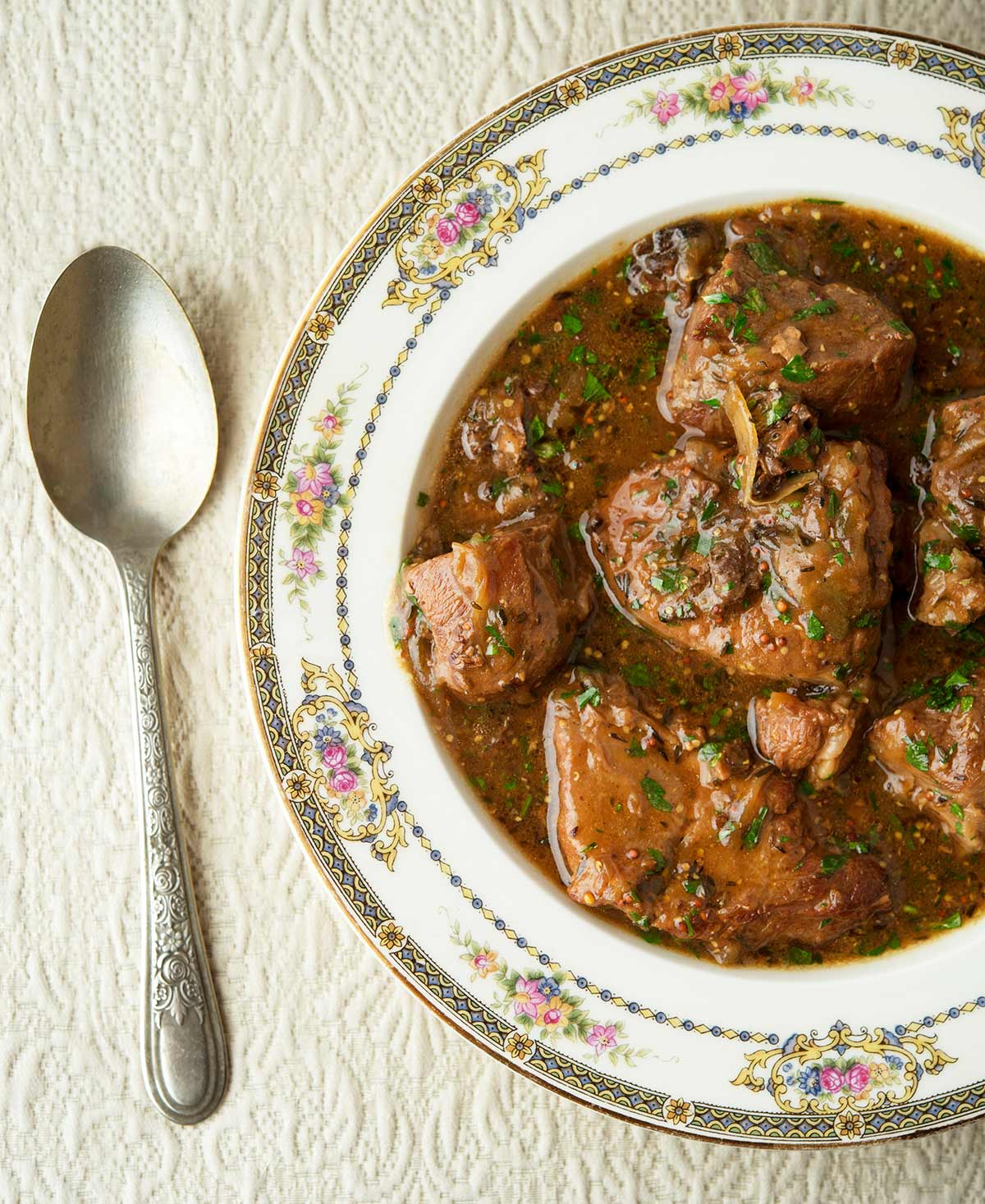
It’s hard to say when carbonnade flamande was invented, but I’d guess sometime in the Middle Ages because it relies on a little bit of sweet-and-sour that is characteristic of that age of cooking.
Regardless of its history, carbonnade (carbon-ah’d) is a damn good dish to make with any sort of red meat. In this case, an elk shank. Deer shanks, beef shanks, or any sort of shoulder or neck meat will also work fine, too.
You can take this carbonnade recipe one of two ways: as a full-on stew, or as a braise you then eat with a knife and fork alongside a starch and a vegetable; the “stew” then becomes the sauce. Holly and I ate ours with mashed potatoes and a salad. Either way you’re in for a treat.
What does it taste like? Well, I like to use the hard-working, sinewy cuts of meat because when they finally do get tender, they get super silky and nice. So you’ve got meat falling off the bone, nestled into a lot of nicely caramelized onions, wild mushrooms and sometimes carrots, which we skipped in this version.
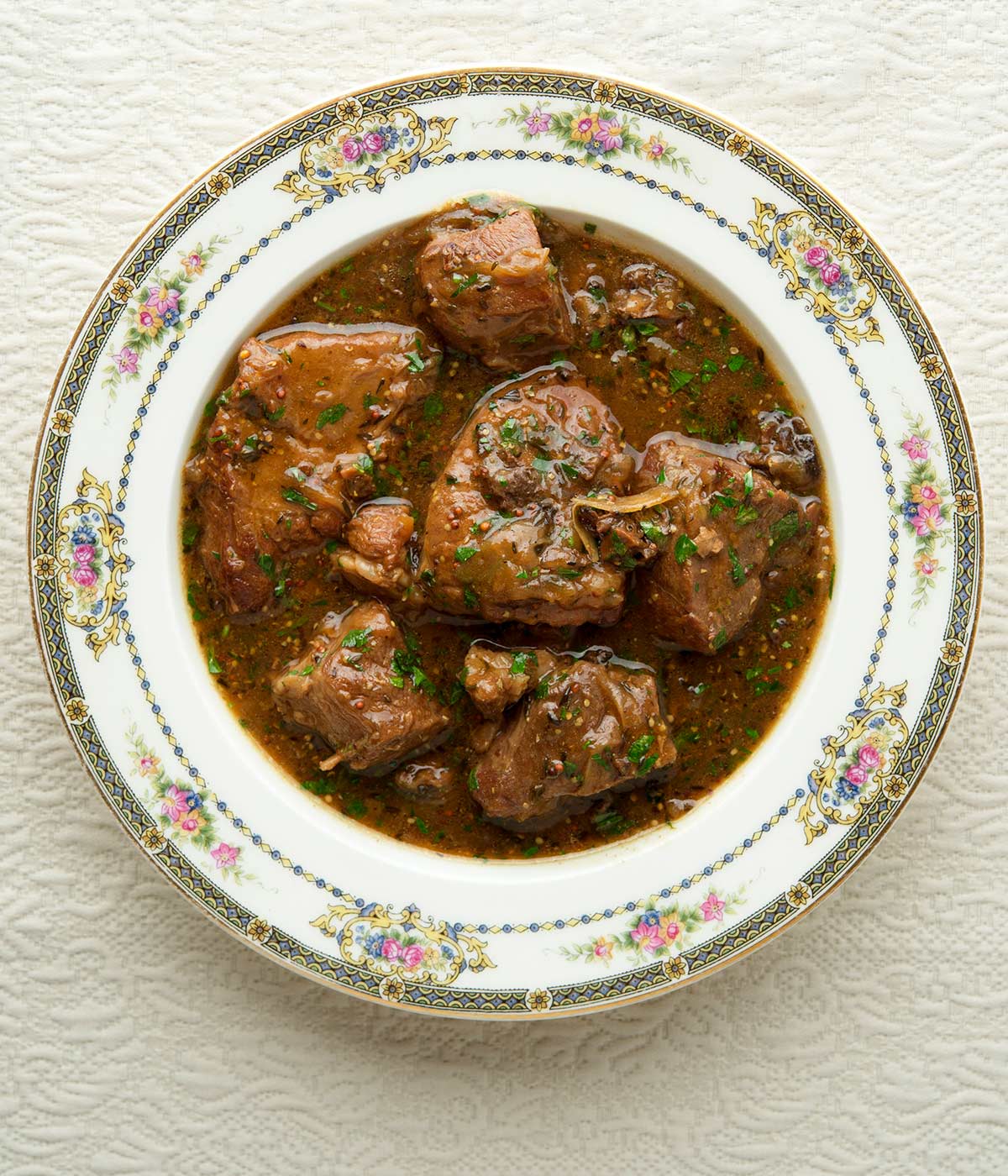
Other root vegetables are also good additions, like parsnips, turnips or rutabagas.
It’s the sauce/gravy/stew that makes Carbonnade flamande special though: Dark, rich with a very European version of that magic combination of sweet-spicy-sour-salty. Mustard, cider vinegar and a little bit of red currant jelly mixed in does this; you can use brown sugar if you can’t find red currant jelly.
It is really, really good. I mean, really good. Make it this weekend and you will thank me later.
The beer matters here. A lot. Make this with a real Belgian abbey ale and you will understand why Carbonnade flamande is such a famous dish.
The mustard is also pretty important, although not as much as the beer. Try to get a natural mustard, like a Dijon, not one with turmeric added for extra yellow. You don’t need color here, you need flavor. As for the mushrooms, I use dried morels or porcini. Any good dried mushroom will do.
Carbonnade flamande fits in well with a host of similar European stews that go well with wild game: Coq au vin, Polish bigos, French garbure, or English shepherd’s pie.
If you liked this recipe, please leave a ⭐️⭐️⭐️⭐️⭐️ rating and a comment below; I’d love to hear how everything went. If you’re on Instagram, share a picture and tag me at huntgathercook.
Belgian Carbonnade
Ingredients
- 3 pounds elk shank, venison shanks or shoulder meat
- 1/4 cup duck fat or unsalted butter
- Salt
- 3 onions, peeled and sliced root to tip
- 1 ounce dried mushrooms, rehydrated in 1 cup warm water and chopped
- 2 teaspoons dried thyme
- 3 or 4 tablespoons flour
- 2 tablespoons mustard, Dijon is best
- 1 cup venison or beef broth
- 1 or 2 bottles of beer, Belgian abbey ale is traditional
- 2 tablespoons cider vinegar
- 1 heaping tablespoon red currant jelly
- Black pepper
- Chopped parsley for garnish
Instructions
- If you are using elk shanks, cut the shank off the bone in large pieces, about 2 to 4 inches across; same thing if you are using shoulder meat. If you are using venison shanks, you can leave them whole if they will fit into your pot.
- Heat the duck fat or butter in a large Dutch oven or heavy lidded pot over medium-high heat. Pat the meat dry and brown it well on all sides. Salt them as they cook. You might need to do this in batches. Remove the pieces as they brown and set aside in a bowl.
- When the meat has all browned, add the sliced onions and mix well. Turn the heat down to medium and cook the onions until they are nicely browned and soft, which can take a solid 20 minutes. About halfway through, salt the onions and add the chopped mushrooms and thyme.
- When the onions are ready, return the meat and all juices from the bowl into the pot. Mix in the mustard, then add enough flour to dust everything in the pot.
- Stir in the mushroom soaking water (strain it if there is debris in it), the venison broth and at least one bottle of the Belgian beer. You want the meat to just barely be covered. Pour in more beer if need be. Bring to a simmer, add salt to taste, cover and cook slowly until the meat is really tender, anywhere from 90 minutes to 4 hours if it's a big ole' bull elk.
- Once the meat is tender, whisk in the red currant jelly, the vinegar and add black pepper to taste. Garnish with the chopped parsley. Serve with spaetzle, egg noodles or potatoes.
Notes
Nutrition
Nutrition information is automatically calculated, so should only be used as an approximation.
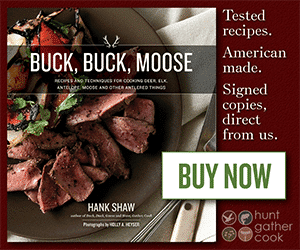
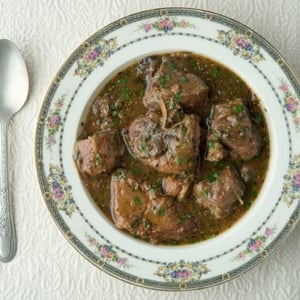
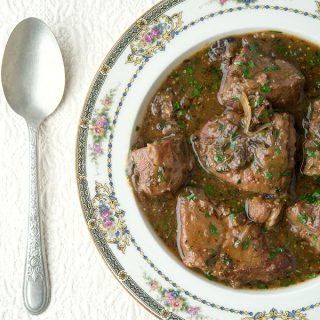

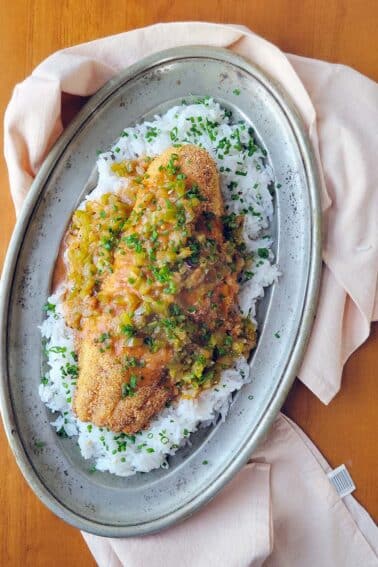
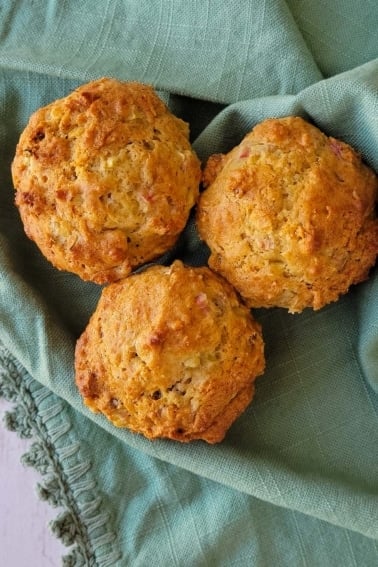

Christmas Eve – Just finished putting everything together from the front quarter of a doe taken last week and hung for a few days, simmering now on the back of the range. The house smells wonderful, I love this recipe. Family and friends are slowly rolling in… Late tonight we will have a some in front of the fire with some bread and wine. If there is any left, I’ll leave a bowl for Santa.
Hi Hank,
Doing something similar today with desert gazelle (I live in Dubai :-). I first marinate the meat cubes in beer, herbs Nd spices for 24h.
Cheers,
Patrice
Hey Hank, when you say “3 pounds Elk shank”, does that means 3 pounds bone in? or 3 pounds of shank meat once removed?
Joe: Bone in.
Made this last Saturday. Loved it, the way it smelled throughout the house was wonderful….4 days later my wife texts me…..”can’t get enough of this deer meat, sooooooo good. Thanks Hank! You made it possible for me to hunt more, “Honey, I am going to Colorado for a week so you can have deer meat!”
Wow. I made this last night. It was awesome.
I just used cuts that I call “stew meat” . Random pieces with lots of connective tissue.
I struggled with the beer and then I found Westmalle Trappist Dubbel at my local store. That was a great find. It was a complicated, flavorful Belgian Abbey Ale. I had a second bottle with dinner and that worked well.
Mine took 3 hours to cook and might have needed a little more time. But this is definitely on the “make again” list.
Carrots are missing from the recipe, which are pretty essential. You’ll see (taste) when you ad a reasonable amount of them it will be even more delicious! This is one of the Belgian national dishes, my favorite as a kid, and served with either cooked potatoes, mashed potatoes or fries, plus salad or maybe even compote. And like the original poster said the beef stew serves as a sauce as the center of the meal (not literally putting it over the potatoes or fries ;)). Bon appétit!
Amazing recipe. For the last two years we’ve trimmed the meat between the ribs off of whitetails and used that meat for this, gotta cook it a bit longer but worth the wait. Also found Chimay to be an excellent beer for this! Fantastic recipe for introducing skeptical people to game meat! Thanks Hank….can’t wait for Buck Buck Moose!
You were right about wanting to thank you later! High bush cranberry jam worked perfectly. I also really like your preambles to recipes. In this case it encouraged me to add carrots. Thanks!
I just made this today and it came out great. I will absolutely make this one again.
Note to Carol (and Hank): Almost all the alcohol from the beer will be gone after 90 minutes to 4 hours (!) of simmering. For instance, if you add 12 ounces of an 8% ABV Belgian Dubbel, you’ll in effect have an ounce of pure alcohol. After simmering for 2 hours roughly 10% of that is left, or 0.1 ounces. Another 30 minutes halves that amount to 0.05 ounces of pure alcohol. For contrast, an ounce of common orange juice naturally contains about that much alcohol.
I’d like to make this recipe with venison shoulder this weekend. Will the alcohol dissipate? Am having friends over and he isn’t supposed to have alcohol because of stomach ulcers and possible liver problems. Maybe I should use a recipe without beer.
Carol: Yeah, don’t do a recipe that hinges on beer then. I have lots of others here, though!
I just made this with Canada goose this weekend and it was a hit all around! You’ve added yet another to our do-it-again list of game recipes – thanks Hank!
Marc
I live in a tiny town in northern Minnesota. We don’t have much in the way of Belgian Abbey Ales. Any other recommendations? An IPA? Thoughts?
Kalia: Get a malty beer, like a nut brown ale, or a porter or a stout. IPA is too hoppy. Blue Moon will work, too.
What size of bottles? Most Belgian Abbey ales I’ve seen are in the large bottles. 2 of those $14 bottles? Have you tried with a good American reproduction beer? Those are usually big too!
Ron: Good point. I tend to use the 22-ounce American beers done in a Belgian abbey style for the cooking. I save the $14 Chimay for drinking with the carbonnade…
I have a whole neck roast from a big buck that would work perfect for this.. thanks!
I made this last night with venison over a roasted root vegetable puree. It was phenomenal. Only change was using elderberry jelly, as that’s what was open in the fridge. The bonus of course was drinking the second half of the St Bernardus 12 after adding it to the pot.
I have some really good honey, would that be an acceptable substitute to the jelly? What about fresh mushrooms? This is definitely on my list for next weekends deer camp out!
Brian: Yep, honey will work. I prefer dried mushrooms to fresh in this recipe, actually.
Coincidentally I had a very similar carbonnade for Sunday lunch and reheated again on Monday for dinner – but with suet dumplings rather than mash. Delicious!
Sounds so good. I’ll use a locally brewed beer and my own wild black cherry jam. I think bear meat prepared this way would be appropriate too.
In appreciation
Carolyn from Ontario
Absolutely…going…to…try…this! Thanks, Hank!